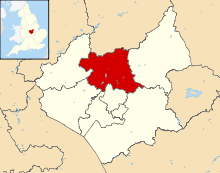Beeby
Beeby is a village and civil parish in the Charnwood district of Leicestershire, England, with a population of 115 according to the 2011 census.[1] It is situated north-east of Leicester, nearer to the villages of Keyham and Hungarton in the neighbouring district of Harborough and lies along the Barkby Brook. This small rural hamlet can be succinctly described as "a series of scattered houses that remain of the shrunken medieval village".[2] The parish also includes the hamlet of Little Beeby, which consists of several houses within the settlement and is located 200m south east of the All Saints Church.[3]
| Beeby | |
|---|---|
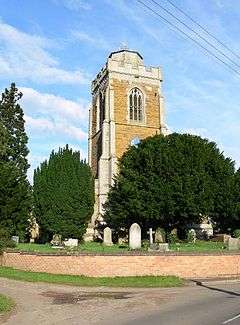 All Saints Church, Beeby | |
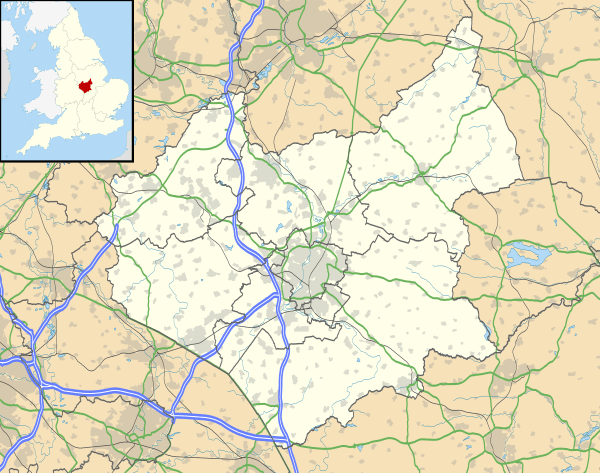 Beeby Location within Leicestershire | |
| Population | 115 |
| OS grid reference | SK6626408298 |
| District | |
| Shire county | |
| Region | |
| Country | England |
| Sovereign state | United Kingdom |
| Post town | Leicester |
| Postcode district | LE7 |
| Dialling code | 0116 |
| Police | Leicestershire |
| Fire | Leicestershire |
| Ambulance | East Midlands |
| UK Parliament | |
History
The villages name is of Anglo-Saxon origin. In the Domesday Book of 1086, the place name was recorded as "Bebi" and derives from the Olde English pre 7th Century "beo", meaning bee, plus the Old Norse "byr", a settlement or village; hence, "bee settlement".[4]
In the 1870s John Marius Wilson described Beeby in the Imperial Gazetteer of England and Wales as:
- "a parish in Barrow-upon-Soar district, Leicester; on an affluent of the river Wreak, 4 miles SE of Syston r. station, and 5½ NE of Leicester. Post Town, Hungarton, under Leicester. Acres, 1,020. Real property, £2,620. Pop., 119. Houses, 26. The property is divided among a few. Beeby House is a chief residence. The living is a rectory in the diocese of Peterborough. Value, £282.* Patron, Earl Shaftesbury. The church is good."[5]
The Parish registers of Beeby commence in 1540, one of the oldest in the county. There was no mention, however, of the name Beeby in the register, as at this time you would only adopt the name 'Beeby' if you were a property or land owner.[6]
Many of the buildings in the village date back to the eighteenth and nineteenth century, mostly designed with Georgian and Victorian periods of architecture indicated by its structure materials. There is no known ancient architectural potential in Beeby, however, within the fields surrounding the conservation area there is underlying archaeological interest where there is evidence of a larger medieval settlement. According to a census report in 1801 there were 25 houses in Beeby, which has risen by only 3 in the following 200 years.[7] At present, many of the 28 buildings in Beeby are grade listed and sell between the prices of £150,000 for small cottages up to £700,000 for the Georgian and Victorian country houses.[8] The village of Beeby is referenced in Adrian Mole & the Weapons of Mass Destruction as the home of the Flowers family.[9]
Demographics
Population
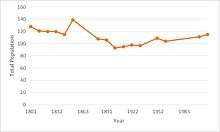
The population of Beeby has always been very small and has changed very little since the Domesday survey in 1098.[10] According to a population census in 1801 it was home to 124 people which rose to 139 in 1851 (the highest recorded since the first population census).[11] This number then fell to 95 in 1991 (the lowest recorded). Population records date back to the 14th century to show there were 96 inhabitants at the time of the Poll Tax in 1377 and a population of 86 at the time of the Ecclesiastical census in 1676. At present Beeby has a population of 115 (60 males and 55 females) 16 of which are children.[12][13]
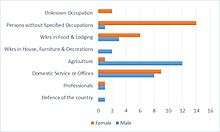
Occupational statistics
The Domesday book census taken in 1086 indicates that there were 21 villains ('peasants', bound to the Lord of the Manor), 5 Sokemen (freemen enjoying extensive rights over land) and 2 servants.[14] The first census in 1801 simply divided people into those involved in agriculture and those in trade and manufacturing. It was only in the 1841 census that first gathered occupational data.[15] According to occupation data reports published in 1881, of Beeby's 108 inhabitants, the majority of males worked in agriculture and females in domestic service.[16] The children of this parish would have attended school in Barkby's Public Elementary School, about 2 miles to the west of Beeby and still do in the present day.[17] Many of Beeby's residents at present work in agriculture and retail, commuting to Leicester for work.[18] The nearest train stations to Beeby are Syston (3.19 miles away) or Leicester (5.09 miles away).[19] Nearby food sources include Picks Organic Farmer & Grower Farm Shop, Gamble and Hollis Butchers, with the large supermarket chains located in Leicester.[20]
Geography
Topography
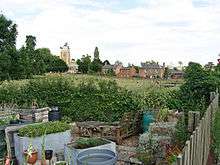
The physical and historical development of the hamlet has been strongly influenced by the local topography and its relative isolation. Beeby is situated within an established agricultural landscape largely in pastoral use. Until 1904 the east-west route was the only route through the hamlet, which was referred to as the Main Road or Barkby Road, connecting the village to Barkby (neighbouring village) and South Croxton. The other roads that now run through Beeby are Hungarton Road, situated to the east and Scraptoft Road, to the south giving the village a more direct link to the outskirts of Leicester.[21] This isolation has mitigated the villages growth over time. This as well as several clusters of cottages and Brewery cottages mixed with informal and open grouping of farmhouses and their associating buildings are features which give this isolated village its character and appeal.
Conservation Area
The Conservation Area was designated in September 1975 and it covers an area of around 6.4 ha (15.8 acres) of gradually sloping land either side of a small tributary stream to the Barkby Brook. This extends along the Main Street and to Barkby Road and essentially relates to the physical extent of the settlement as it was at the end of the nineteenth century. The conservation area is protected by the Regional Spatial Strategy for the East Midlands (RSS) which advises local authorities to develop strategies that avoid damage to the region's cultural assets.[22]
Historic sites and landmarks
All Saints Church: The Anglican parish church is dedicated to All Saints and seats 100 people.[23] It stands alone looking over parkland within the village.[24] It was built with orange ironstone in the fourteenth century with the interior featuring a thirteenth century font and decorated with carvings that date throughout the churches history.[25] The tower was added to the building in the fifteenth century.[26] The church has a truncated steeple (often referred to as the 'Beeby Tub'), unfinished due to the legend of two stonemasons quarrelling and falling to their death.[27] The churches slightly raised setting ensures that it is the focal point for views from all directions across the valley.
The Manor House, Beeby: A grade II listed building dating back to the late 18th century, located on the west side of the main street.[28]
References
- "(Parish):Key Figures for 2011 Census: Key Statistics". Neighbourhood statistics. Office for National Statistics. Retrieved 25 March 2014.
- Pevsner, Nikolaus (1985). The Buildings of England- Leicestershire and Rutland. Yale University Press. ISBN 0300096186.
- Pevsner, Nikolaus (27 April 2014). The buildings of England: Leicestershire and Rutland. Great Britain: The Penguin Group. p. Page.95. ISBN 0300096186.
- "Name Database: Beeby". 1980 - 2014 Name origin search. Retrieved 28 March 2014.
- Wilson, John Marius (1870–72). Gazetteer of England and Wales. Edinburgh: Imperial. Retrieved 27 February 2014.
- "Research about the name and village of Beeby". Registered Families. Roger Beeby of Leicester. Retrieved 27 April 2014.
- "Vision of Britain". Total households, as defined by the relevant census. University of Portsmouth. Retrieved 27 April 2014.
- "Right move". Property Prices in Beeby, Leicestershire. Land Registry. Retrieved 27 April 2014.
- Adrian Mole and the Weapons of Mass Destruction
- Beeby, Roger. "Research about the name and village of Beeby". Population since Domesday. Roger Beeby of Leicestershire. Retrieved 27 April 2014.
- "Beeby: Population Statistics". Historical Statistics. University of Portsmouth. Retrieved 26 April 2014.
- "Neighbourhood statistics: Accommodation Type". Household count. Office for National Statistics. Retrieved 27 April 2014.
- "Age by single year, 2011". Neighbourhood Statistics. Office for National Statistics. Retrieved 27 April 2014.
- "Open Domesday: Beeby". Anna Powell-Smith. Retrieved 13 January 2016.
- "Beeby CP/AP: Social Status, based on 1831 occupational statistics". Vision of Britain Through Time. University of Portsmouth. Retrieved 27 March 2014.
- "Beeby CP/AP: Occupation data". Vision of Britain Through Time. University of Portsmouth. Retrieved 13 January 2016.
- "Schools attended by the children of Beeby". Uk and Ireland Genealogy. Retrieved 13 January 2016.
- "Industry, Beeby". Neighbourhood Statistics. Office for National Statistics. Retrieved 27 April 2014.
- "Train stations near Beeby". Google Maps. Retrieved 27 April 2014.
- "Local Food Shops and Producers". Food Sources for Beeby. BigBarn. Retrieved 27 April 2014.
- "Transportation Routes through Beeby". Beeby, Leicestershire. Bing Maps. Retrieved 27 April 2014.
- "Regional Spatial Strategy for the East Midlands (RSS)". Archived from the original on 27 March 2014. Retrieved 27 March 2014.
- "Beeby church history". Information about All Saints church. Uk & Ireland Genealogy. Retrieved 27 April 2014.
- "Britain Express". All Saints Church. Britain Express. Retrieved 26 April 2014.
- "Beeby All Saints Church". David Ross. Retrieved 27 March 2014.
- "The Churches Conservation Trust". visitchurches.org. Retrieved 27 March 2014.
- "Researches about the name and village of Beeby". All saints church steeple. Roger Beeby of Leicester. Retrieved 27 April 2014.
- "The Manor house, beeby". British listed buildings. English Heritage. Retrieved 28 March 2014.
| Wikimedia Commons has media related to Beeby. |
